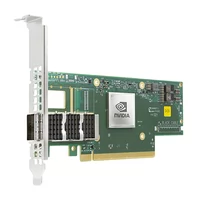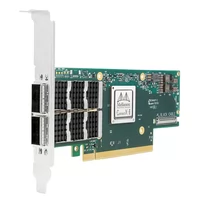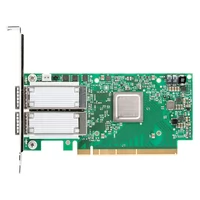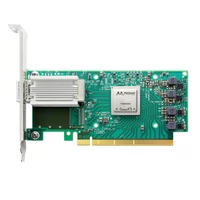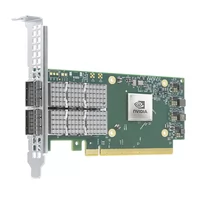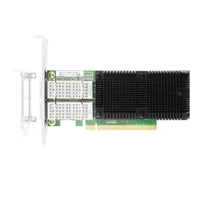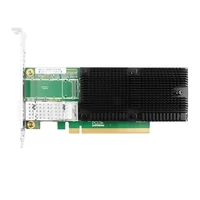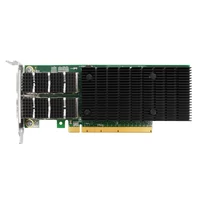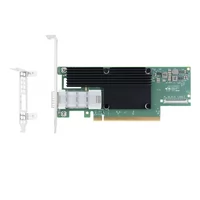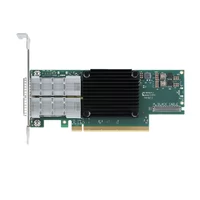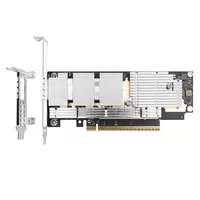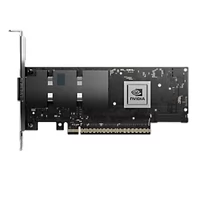In the digital world we live in today, it is important for network systems to function at their peak level. One component that makes up this system is a NIC, or Network Interface Card. This article will go into great detail about what NICs are and why they’re needed; additionally, it will also explore various technical specifications as well as how these cards have worked throughout different generations until now. By knowing more about how these things work together, readers can better understand why we need such devices for computers to communicate with each other on networks seamlessly. They might be interested in learning this stuff if they work as an IT specialist, have a deep understanding of technologies, or are just passionate about hardware knowledge connected with networks – everything that you want to know about NICs is here!
Table of Contents
ToggleWhat is a Network Interface Card?
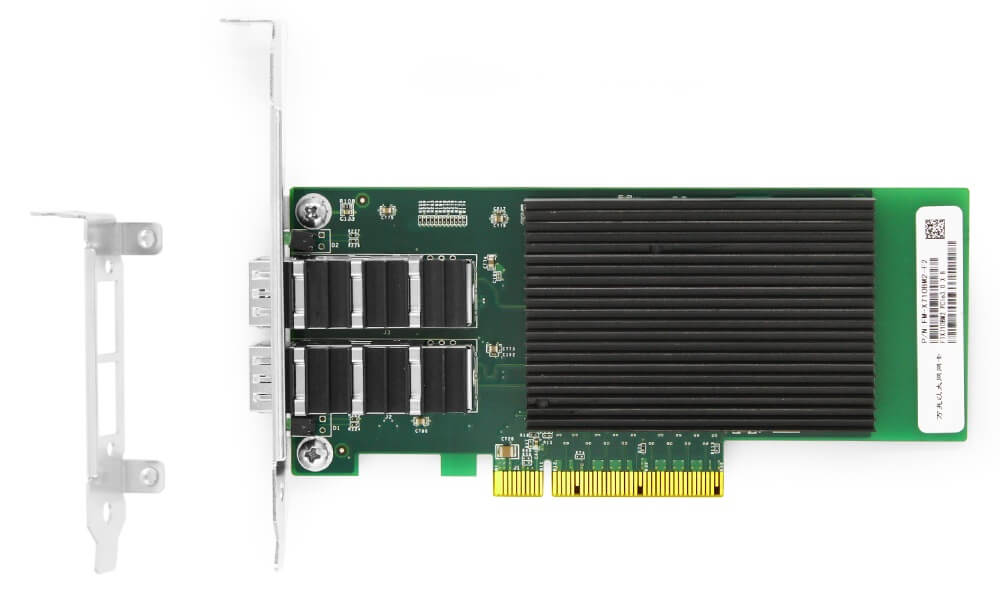
NIC Definition and Basic Components
A Network Interface Card (NIC) is a hardware device that enables a computer to communicate with a network. It acts as the door through which information goes in and out of the computer by allowing devices to connect either to local area networks or the internet. A NIC consists of various parts including:
- Controller: This is the brain of the NIC. It handles all transmission and reception of data.
- Transceiver: In fiber optics, electrical signals are converted into optical signals and vice versa.
- Connectors/Ports: These are points where network cables plug into such as Ethernet ports.
- EEPROM/Flash Memory: Configuration of data storage location and firmware for the NIC.
- Bus Interface: The connection point between the computer’s motherboard and the NIC; usually through PCI, PCIe or USB interfaces
All these parts work together to enable this card to perform its main function, which is providing an interface between computers and networks, hence enabling the exchange of data as well as connectivity across different systems within a given environment.
Main Functions of a Network Interface Card
Some of the main roles of a Network Interface Card (NIC) are as follows:
- Sending and receiving data: A NIC is responsible for transmitting and receiving data packets between a computer and a network to enable smooth communication.
- Error detection and correction: NICs have error-checking features that help identify and fix errors during transmission, thereby improving the faithfulness and dependability of data exchange.
- Addressing & routing: NICs together with network protocols give addresses to data packets as well as directing them towards their right destinations within a given network.
- Access control: For example, in Ethernet networks, Carrier Sense Multiple Access with Collision Detection (CSMA/CD) is used by NICS to manage medium access within networks.
- Protocol support: Different types of network protocols are supported by NICS such as TCP/IP or IPX/SPX which ensures compatibility with multiple networks thus enabling seamless communication across different systems.
These functions make it possible for a NIC to establish strong, efficient, reliable network connections on behalf of the computer.
Physical and Data Link Layers: The Role of NIC
The Network Interface Card (NIC) has a crucial position in the OSI model between the Physical Layer and Data Link Layer. At the Physical Layer, the NIC is responsible for managing electrical signals that represent data across a network medium. This involves converting digital data from computer into signals which can be transmitted over medium as well as vice versa.
On the other hand, at the Data Link layer of the OSI Model, NIC takes care of framing data packets, i.e., adding necessary headers and trailers for error detection and flow control. It also deals with Media Access Control (MAC) addressing so that information packets are delivered to the correct hardware address on the network. Additionally, this layer consists of protocols like Ethernet which must be implemented by NIC to enable proper exchange of data. By performing tasks efficiently both at the Physical and Data Link layers, NIC ensures reliable communication between computer & network by transmitting accurate information.
What are the Different Types of NICs?
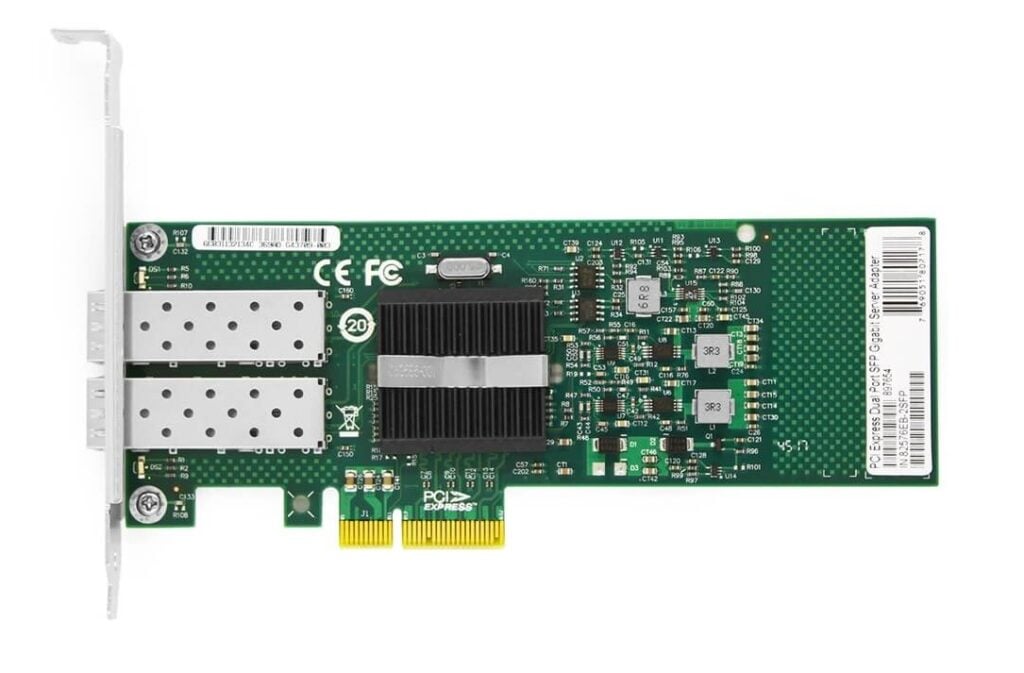
Wired vs Wireless NICs: Key Differences
Wired NICs:
- Connectivity: Wired network interface cards (NICs) need physical connections, including Ethernet cables, to be integrated into a network. This typically results in a more stable and faster connection.
- Speed and Reliability: Normally, wired connections are faster in data transfer rates and have lower latency compared to wireless connections. They are also less affected by interference from other electronic devices or physical obstructions.
- Security: Generally, connecting through wired NICs is believed to be safer because it requires one to have physical access to the network thereby minimizing chances of unauthorized access.
Wireless NICs:
- Connectivity: Wireless NICs utilize radio waves for network connection, which allows more flexibility when positioning devices as no physical cables are involved. They are most suitable for mobile devices and settings where it is difficult or impossible to run cables.
- Speed and Reliability: Although wireless networks have become faster and more reliable over time, they can still suffer from speed fluctuations or reliability drops caused by factors such as interference, congested channels or limited range.
- Security: Unlike with wired networks, wireless NIC security may easily be threatened by unauthorized entry into the system or eavesdropping on communications. Therefore, strong authentication protocols, along with encryption, should always be used for securing wireless connectivity.
Each type of network card has its own benefits and drawbacks that should be considered when deciding what will work best given particular needs and constraints within an environment.
Ethernet NIC Cards: Common Use Cases
Ethernet network interface cards (NICs) are widely used in a variety of settings because they are fast, reliable, and secure. Enterprise networks are one area where they shine. They create strong connections for servers, workstations, and other important components within an organization’s infrastructure. These types of setups need low latency and high data transfer rates to accommodate large amounts of traffic generated by bandwidth-hungry applications.
Data centers also find Ethernet NIC cards indispensable pieces of hardware. They help keep networking equipment running smoothly and efficiently. By dealing with hefty throughput requirements while ensuring minimal downtime is experienced; which would be disastrous for cloud services or large-scale storage systems that rely on constant availability through these facilities.
In addition to this, small office or home networks can greatly benefit from using Ethernet NIC cards too! When it comes down to it, nothing beats these types of connections for reliability or security when connecting devices such as desktop PCs, gaming consoles, Network Attached Storage (NAS) drives, etc., directly onto local LANs (or even the Internet itself). For people who want stable and high-speed internet connections – perhaps for streaming movies/shows online, playing games over the web or performing remote desktop work over VPN links back into corporate environments etc – wireless alternatives simply do not offer the same level of performance as wired ones do.
Choosing the Right NIC for Your Network
To ensure the best performance and compatibility, there are many things that need to be taken into account when choosing a Network Interface Card (NIC) for your network. First and foremost among these is bandwidth requirement: you must evaluate the data transfer speed that your network demands. NICs which support Gigabit Ethernet or even 10 Gigabit Ethernet should be considered for high-performance requirements.
Secondly, it is important to consider the compatibility with existing hardware and software. Make sure that the NIC is compatible with your operating system and motherboard slot type (like PCIe). To future-proof the network, select those NICs that can support advanced features such as VLAN tagging, load balancing, or remote management because they improve the efficiency and scalability of a network.
Thirdly, one should look at the environment where this network will be deployed. In an enterprise or data centre setting, for example, security would be paramount; hence, one needs to choose a NIC with robust security features, low latency, and high reliability. However, for home or small business use, cost-effective solutions that still provide good performance and stability should be chosen instead.
By closely examining these elements alongside reputable manufacturer specifications reviews, appropriate NICS can be identified for specific networking needs.
How does a Network Interface Card Function?
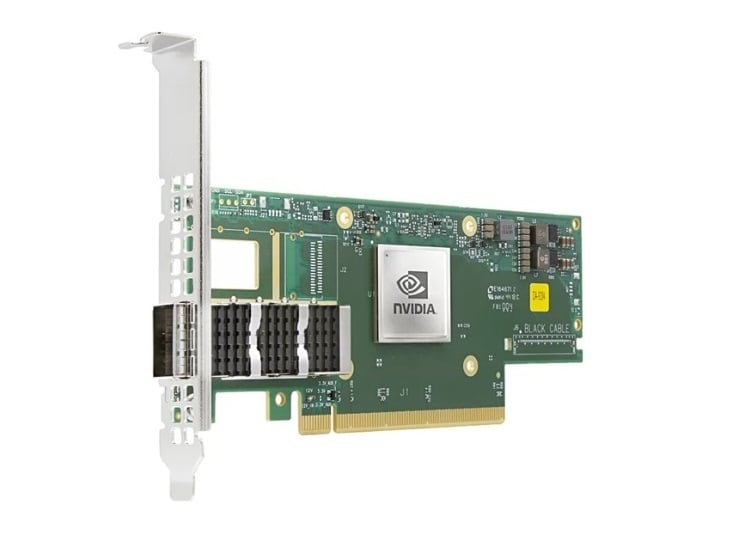
Data Transfer Process in a NIC
A Network Interface Card (NIC) acts as a bridge between a computer and the network it is connected to, thus facilitating orderly data transfer. Initially, the NIC receives data packets from the computer’s central processing unit (CPU). These packets are divided into smaller frames which can be transmitted over the network.
Afterwards, necessary headers are added to these frames by NIC which contain important information like source and destination addresses; this is important so that data reaches its intended destination correctly. Then NIC converts parallel data to serial data for network transmission protocols.
When it comes to transmitting data on the network, NICs use various signaling methods, either wired or wireless media. However, when receiving data, it does exactly the opposite, i.e., converts incoming serial back into parallel format, then strips off headers and reassembles packets before passing them back to the CPU.
By doing all these operations invisibly, NIC ensures that there is effective and error free communication between computers within a given network hence supporting different types of networking applications.
Roles of NIC in Different Network Layers
A Network Interface Card (NIC) works across several layers of the OSI (Open Systems Interconnection) model, with each layer having different functions:
- Physical Layer (Layer 1): This lowest level involves the NIC dealing with hardware connections to the network medium such as Ethernet cables for wired connections and antennas for wireless ones. It converts digital data from the computer into electrical, optical or radio signals required for transmission over the network medium.
- Data Link Layer (Layer 2): In this layer, MAC (Media Access Control) addressing is handled by NICs to ensure that data packets are framed, error-checked and directed towards the right hardware address within the local network. It facilitates node-to-node data transfer and controls access to the network medium especially in a shared network environment.
- Network Layer (Layer 3): Although most NIC functions are performed at physical and data link layers, some advanced NICs provide support for network layer capabilities like offloading TCP/IP processing tasks. This can involve managing IP addresses, routing data between different networks, and enabling faster throughput through CPU offload.
The NIC therefore acts as an intermediary at different levels of networking which ensures smooth communication as well as efficient data transfer within/between networks.
Bandwidth and Speed Capabilities of NICs
The speed and bandwidth capabilities of Network Interface Cards (NICs) vary greatly depending on the design, technology used, and their purpose. There are a number of NIC types commonly found in modern networks:
- Ethernet NICs: Starting from 10/100 Mbps Fast Ethernet adapters to Gigabit Ethernet (1 Gbps), 10 Gigabit Ethernet (10 Gbps) and beyond, up to 100Gbps for high-performance data centers. Higher-speed Gigabit NICs and above offer higher data throughput thus suitable for large-scale networks as well as data-intensive applications.
- Wireless NICs (Wi-Fi): Wireless NIC speeds correspond to the supported Wi-Fi standard. For example, 802.11ac (Wi-Fi 5) based NICs can provide up to 3.5Gbps while the latest Wi-Fi 6 (802.11ax) based ones can achieve theoretical speeds over 9.6Gbps which enhances network efficiency by reducing latency especially when multiple devices are involved concurrently.
- Fiber Optic NICs: These NICs primarily target enterprise environments supporting anywhere between 1-100Gbps+ using fiber optics for long-haul or high-bandwidth connections where ultra-low latency and high reliability are mandatory such as backbone network infrastructure or DCI (Data Center Interconnect).
In brief, these days’ performance requirements in networking demand that we have adequate bandwidth along with fast enough speeds within Network interface cards so that there is effective data transfer across different environments while ensuring strong connectivity as well.
What are the Common Problems with NICs?
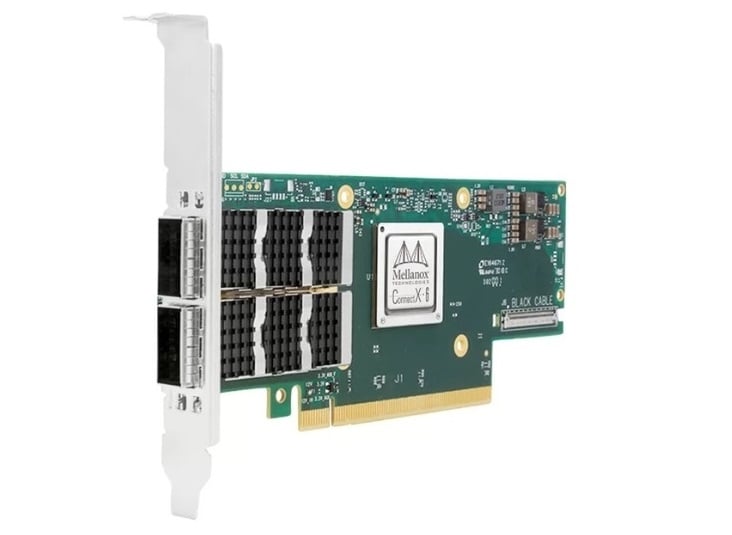
Troubleshooting NIC Connectivity Issues
When you are trying to fix NIC connectivity issues, it’s important that you follow a step-by-step process so that you can find and fix the problem as quickly as possible. Here are some common steps:
- Check Physical Connections: Make sure all cables are securely plugged in and not visibly damaged. This includes checking the Ethernet cable connections and inspecting the network port for any debris.
- Confirm Network Settings: Check that the device has the correct network settings. This involves verifying IP address, subnet mask, gateway settings etc., whether configured manually or obtained automatically through DHCP.
- Update Drivers: Outdated or corrupt NIC drivers can cause connection problems. Download the latest manufacturer drivers from their website or use driver update software to install them.
- View NIC Status: Open device manager and look at status of your Network Interface Card (NIC). If there’s anything wrong with it, generally indicated by an exclamation mark next to its name then this is where you’ll see it.
- Disable/Enable NIC: Occasionally just turning off then on again can resolve connectivity issues so try disabling/enabling through either network settings or device manager interface.
- Test With Different Device: Whenever possible, connect another device to the same port/network jack to determine if the problem lies within the NIC itself versus the infrastructure surrounding it, such as wiring, etc.
- Reset Networking Configuration: Resetting all network configurations back to default sometimes fixes misconfigurations, often achieved via network settings or command line tools like ipconfig for Windows systems and ifconfig in Unix-like environments.
- Interference Check (Wireless NICs): Ensure minimal signal interference from other electronics while staying within optimal range proximity between wireless adapter card (NIC) being used & WAP (wireless access point).
Following these procedures will help identify most of the common reasons why a computer might fail connecting with others over the internet using Ethernet technology.
Common Software and Hardware Failures
Mistakes in Software
- Errors of Operating System: These can take place when files in the system get corrupted. They may also be caused by incomplete installation of updates or malware infection. You know that this is happening if your computer crashes frequently, shows blue screen and never boots.
- Application Crashes: Application software can crash because of bugs, lack of enough resources or incompatibility with other programs. Ensuring that you regularly update such applications through patches from their developers will help reduce this problem to some extent.
- Data Corruption: File corruption might result from improper shutdowns or hardware failures among others like filesystem errors. Backing up data on regular basis and making use of file recovery tools are among measures one can take against data corruption effects.
Hardware Breakdowns
- Hard Drive Failures: Mechanical faults, bad sectors, and firmware issues are common causes of hard drive failures. These can cause slow performance and abnormal sounds when the drive fails, resulting in the entire system crashing too often. This is why one should do backups regularly and use SSDs where necessary.
- Overheating: Poor ventilation, dust accumulation within components such as CPU and GPU, or failure in cooling systems could cause overheating, leading to instability within a system and physical damage to its parts. Cleaning frequently and ensuring sufficient air flow will prevent this condition called overheating, thus keeping your PC safe always.
- Power Supply Problems: Random power cuts due to an unreliable power supply have the potential to damage hardware and cause system instability, which blackouts may sometimes bring about. For better protection against these hazards, it is recommended that you employ a good power supply unit (PSU) together with an uninterruptible power supply (UPS).
These are the most frequent types of failures in both software and hardware components so understanding them would greatly improve the efficiency in performance reliability levels for any given computer system.
How to Replace or Upgrade a Faulty NIC
To restore lost network functionality and improve data transfer rates, it may be necessary to replace or upgrade a faulty Network Interface Card (NIC). Do the following:
- Find the Faulty NIC: Make sure that it is the NIC causing connection problems. This can be done with network diagnostics tools in your operating system or by checking if other network hardware and cables work properly.
- Power Off and Unplug the System: Turn off your computer safely and unplug it from a power source. Ground yourself to avoid static discharge that can harm internal components.
- Open the Case: Use a screwdriver to remove screws and open the case of your computer. The defective NIC should be situated on the motherboard, typically in a PCI or PCIe slot.
- Take Out the Faulty NIC: Unscrew or unclip any fasteners which keep NIC in place. Carefully pull the NIC out of its slot not to damage the motherboard.
- Install New NIC: Put new NIC into an appropriate slot. Ensure that it is firmly inserted and fix with screws or clips if needed.
- Close Case and Reconnect System: Return the cover of the computer’s case back and secure it with screws. Connect all power as well as network cables again.
- Power On and Install Drivers: Switch on your PC now and install necessary drivers for new NIC. Drivers are often located at manufacturer’s website or supplied on disc together with hardware.
- Test New NIC: Check whether you have installed another network card correctly by verifying connectivity through networks along with running diagnostic utilities for ensuring proper installation.
These steps will help you quickly replace or upgrade an unreliable Network Interface Card (NIC), thereby improving performance & dependability within your system’s networks.
How to Install and Configure a NIC?
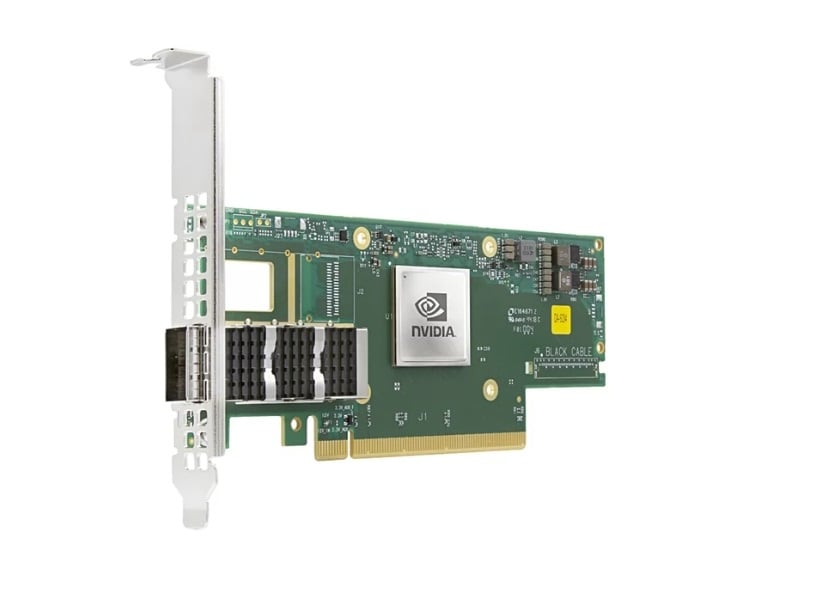
Step-by-Step Installation Guide
- Collect the right tools and equipment: Make sure you have a good NIC, screwdriver, software and drivers. Download the latest drivers from the manufacturer’s website.
- Fix your workplace: Turn off your computer system unit, unplug it from the power source and move it to a clean desk which is free from static electricity. Connect yourself with the ground to avoid any damage that might be caused by electrostatic discharge (ESD).
- Open up the computer case: Unscrew all screws on either side of your CPU and gently open it in order to access the motherboard.
- Find where to put the network card: Identify which slot is empty among PCI or PCIe slots that are found in the motherboard to install NIC.
- Install network card: Just insert selected NIC into its slot tightly enough. You can as well use an existing screw from one of the slot covers or provided screw to secure network interface card firmly in place.
- Close computer case: Reassemble everything back together by closing up the PC Case again using the screws removed earlier on. also, reconnect all cables coming out through different ports, such as Ethernet cable for internet connection, among others, then plug into the power outlet before turning on the machine once more time.
- Turn On And Install Drivers: Switch on your personal computer, then install the required drivers for Network Interface Card immediately after booting up the system if prompted; otherwise, use the driver disc supplied or download the latest version from the manufacturer’s site.
- Configure Network Settings: Go to Network settings within Control Panel or System Preferences. Depending on the operating system being used, set IP addresses as well as other necessary network configurations demanded by the given LAN setup.
- Test Network Interface Card Functionality: Join this new network via said installed device while checking whether internet connectivity is established at any point during these initial stages you may employ diagnostic tools or perform ping tests between various hosts ensuring there is end-to-end communication across entire local area network (LAN).
To get faster connection speeds on your computer system, you will have to follow through this guide that has been presented above so as to install and configure a new NIC which should help increase network connectivity and performance for your PC.
Configuring Network Settings for Optimal Performance
For best results in network settings, follow the steps below:
- Update Network Drivers: Make sure that you have the latest drivers installed for your Network Interface Card (NIC). If your driver is obsolete, it can cause performance problems as well as instability. The manufacturer’s website should be checked for any new updates regarding this matter.
- Set the Right Network Mode: You must configure your NIC to operate in the correct mode such as Auto-Negotiation or Full Duplex. While auto-negotiation is generally good for compatibility with other devices and provides better overall performance, there may be cases where it would be advantageous to set a fixed mode like full duplex especially when dealing with certain types of networks.
- Enable Jumbo Frames: Activate jumbo frames if your network infrastructure supports them because doing so will allow larger data packets to be sent which can significantly boost throughput. This feature works by reducing CPU utilization thus improving processing efficiency particularly in high-speed networks.
- Optimize TCP/IP Settings: Modifying TCP/IP settings has a great impact on enhancing network speed. Increase the value of parameters such as TCP Window Size, TCP Chimney Offload and Recv Segment Coalescing (RSC) so as to improve throughput while lowering latency through this technique. Normally these adjustments are made within operating system’s network settings or registry editor.
- Prioritize Network Traffic: Use Quality of Service (QoS) mechanisms to give priority treatment on important traffic flows across networks. For example, voice over IP (VoIP) calls or streaming media should not experience packet loss due to congested links hence low latency must be guaranteed along with sufficient bandwidth allocation for optimal performance under such scenarios.
- Disable Unnecessary Protocols and Services: Turn off those protocols or services which are not needed by your current connection like IPv6 if it is not being used by any application within the local area network or File and Printer Sharing if there are no shared resources on this computer. By doing this we can minimize network overhead thus reducing any potential security risks associated with running these unnecessary features.
- Regularly Monitor and Adjust Settings: Keep monitoring the performance of your network continuously and alter settings where necessary. In order to identify bottlenecks in real time and optimize them, you should employ various network monitoring tools.
By following these steps, you will be able to fine-tune your network settings so that it performs at its best, hence resulting in a faster, more reliable internet connection.
How to Maximize the Performance of Your NIC?
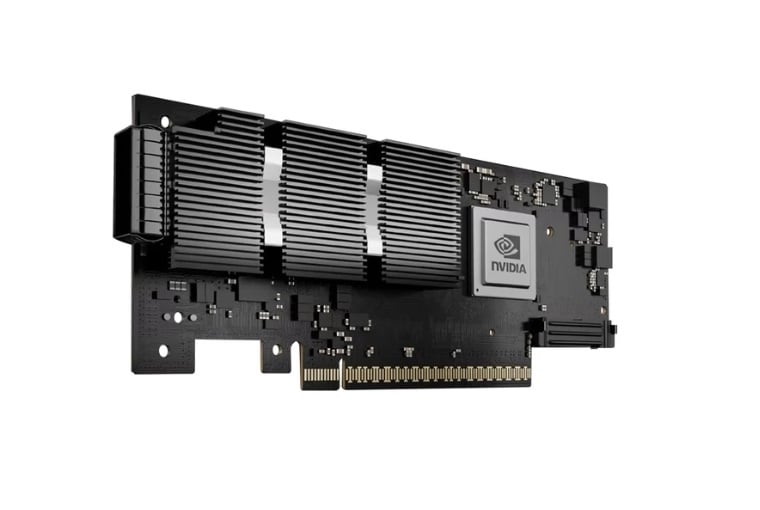
Tips for Enhancing NIC Performance
- Upgrade NIC Drivers: You can increase performance dramatically just by ensuring that the drivers for your Network Interface Card are current. Manufacturers frequently release these updates to boost speed, add options and fix problems; thus you should visit their website in search of such improvements.
- Activate Receive Side Scaling (RSS): With RSS, multi-core workload sharing becomes possible as it helps distribute tasks from network traffic across various processors which leads to improved throughput while decreasing latency. Enable this option through properties related to your OS setting’s NIC.
- Tweak Interrupt Moderation: Latency vs throughput is a balancing act and one way to achieve this balance is by configuring interrupt moderation. The higher the rate of interrupt moderations, the lower CPU loads may be at the cost of increased lags or vice versa. Adjust them via NIC settings according to your network usage scenario.
Best Practices for Maintaining Your NIC
- Regularly Update Firmware and Drivers: Regular updating of the firmware and drivers for your Network Interface Card (NIC) is important in ensuring the effective and secure functioning of this device. Firmware that is up-to-date can improve performance by adding new capabilities as well as fixing known problems. Regularly check the manufacturer’s website for updates and follow their installation procedures.
- Monitor Network Activity: Monitor NIC performance and network traffic by utilizing network monitoring tools. This will help you detect issues before they become major problems, such as bottlenecks, high latency, or unexpected traffic patterns. It also enables proactive adjustments so that peak NIC performance can always be maintained.
- Optimize NIC Settings: Performance may be enhanced through adjustment of various settings in the NIC, such as Jumbo Frames, Receive Side Scaling (RSS), and Interrupt Moderation. CPU workload is reduced while throughput is increased by sending larger packets with Jumbo Frames. On the other hand network traffic load can be distributed across multiple processors by RSS. According to your specific network requirements find out which Interrupt Moderation setting suits best between latency and CPU usage.
- Keep the NIC Free of Dust and Debris: Physical cleanliness counts too; hence, ensure that both slots where it is inserted are clean, besides keeping dust off from around it so that hardware failures do not occur due to overheating. Cleanliness should, therefore, not be taken for granted because it contributes towards elongating its lifespan as well as retaining its efficiency over time.
- Secure the NIC and Network: Protect the NIC together with all other devices connected to a particular network from cyber attacks by implementing strong security measures around them without any compromise whatsoever. Some steps that can be taken include enabling firewalls, configuring access control lists (ACLs), and using encryption protocols, among many others available out there today. When unauthorized persons gain entry into a given area, there are chances that they might tamper with system settings, thereby causing harm either directly or indirectly to these devices.
Frequently Asked Questions (FAQs)
Q: Explain to me what a Network Interface Card (NIC) is.
A: A computer hardware component that allows connections between devices forming networks thereby linking them for communication.
Q: What do you know about different types of NICs?
A: There are two main kinds of network interface cards; wired NICS which utilize ethernet cables and wireless Nics that connect computers to wireless networks. In addition, there are server NICs as well as USB NICs created for specific purposes.
Q: How does a NIC work?
A: The work of translating data from one computer into another language so that it can be sent over the wire is done by a NIC. Besides being responsible for managing physical and data link layers in networking, this card also takes care of network layer functions such as packetizing and connection service provision, among others, while operating at these levels.
Q: What is a wired NIC?
A: It refers to any kind of Ethernet Card or any other type of network interface card that connects a computer to the Internet using wires instead of radio waves or any form wireless communication technology. These cards are plugged directly into an expansion slot on the motherboard inside your PC Tower Case.
Q: What is a wireless NIC?
A: A wireless network adapter enables computers to connect with networks without using cables. It uses radio waves instead which are then transmitted through an antenna located on top part called access point AP or simply router in homes and small businesses.
Q: What are the typical entrance points on NIC?
A: RJ-45 ports for connecting ethernet cables and sometimes USB ports for connecting USB NICs. There are also fiber optic connections available for high-speed data network needs.
Q: How do you pick a NIC card for your computer?
A: When selecting a network card, you should consider the type of network that you plan to connect with, required speed (such as gigabit networks), and whether it needs to be wired or wireless. Compatibility with your computer’s motherboard and presence of necessary ports should also be taken into account.
Q: What is the function of N.I.C. in an N.I.C. Card?
A:The Network Interface Controller processes incoming/outgoing data packets through that interface between devices; it ensures that these packets reach the correct destination on the network; also plays an essential role in traffic management within networks.
Q: Can one computer have more than one network interface card?
A:Yes.A single machine can possess multiple NICs concurrently so that it connects to various networks at once.This allows servers to handle different networks’ traffics more efficiently or computers linked up with both local area network (LAN) and wide area network (WAN).
Q :Why is a N.I.C important part of any Networking system?
A:A computer cannot communicate with other devices on a network if there is no way for it to connect itself onto that system.The crucial aspect about this hardware component is its capability of establishing links between computers themselves by allowing them share resources and information through communication while still being able access internet services.
Related Products:
-
 NVIDIA NVIDIA(Mellanox) MCX653105A-ECAT-SP ConnectX-6 InfiniBand/VPI Adapter Card, HDR100/EDR/100G, Single-Port QSFP56, PCIe3.0/4.0 x16, Tall bracket
$965.00
NVIDIA NVIDIA(Mellanox) MCX653105A-ECAT-SP ConnectX-6 InfiniBand/VPI Adapter Card, HDR100/EDR/100G, Single-Port QSFP56, PCIe3.0/4.0 x16, Tall bracket
$965.00
-
 NVIDIA NVIDIA(Mellanox) MCX653106A-ECAT-SP ConnectX-6 InfiniBand/VPI Adapter Card, HDR100/EDR/100G, Dual-Port QSFP56, PCIe3.0/4.0 x16, Tall Bracket
$828.00
NVIDIA NVIDIA(Mellanox) MCX653106A-ECAT-SP ConnectX-6 InfiniBand/VPI Adapter Card, HDR100/EDR/100G, Dual-Port QSFP56, PCIe3.0/4.0 x16, Tall Bracket
$828.00
-
 NVIDIA NVIDIA(Mellanox) MCX516A-CCAT SmartNIC ConnectX®-5 EN Network Interface Card, 100GbE Dual-Port QSFP28, PCIe3.0 x 16, Tall&Short Bracket
$985.00
NVIDIA NVIDIA(Mellanox) MCX516A-CCAT SmartNIC ConnectX®-5 EN Network Interface Card, 100GbE Dual-Port QSFP28, PCIe3.0 x 16, Tall&Short Bracket
$985.00
-
 NVIDIA NVIDIA(Mellanox) MCX515A-CCAT SmartNIC ConnectX®-5 EN Network Interface Card, 100GbE Single-Port QSFP28, PCIe3.0 x 16, Tall&Short Bracket
$715.00
NVIDIA NVIDIA(Mellanox) MCX515A-CCAT SmartNIC ConnectX®-5 EN Network Interface Card, 100GbE Single-Port QSFP28, PCIe3.0 x 16, Tall&Short Bracket
$715.00
-
 NVIDIA MCX623106AN-CDAT SmartNIC ConnectX®-6 Dx EN Network Interface Card, 100GbE Dual-Port QSFP56, PCIe4.0 x 16, Tall&Short Bracket
$1200.00
NVIDIA MCX623106AN-CDAT SmartNIC ConnectX®-6 Dx EN Network Interface Card, 100GbE Dual-Port QSFP56, PCIe4.0 x 16, Tall&Short Bracket
$1200.00
-
 Intel® E810-CQDA2 100G Ethernet Network Adapter PCIe v4.0 x16 Dual port QSFP28
$589.00
Intel® E810-CQDA2 100G Ethernet Network Adapter PCIe v4.0 x16 Dual port QSFP28
$589.00
-
 Intel® E810-CQDA1 100G Ethernet Network Adapter PCIe v4.0 x16 Single port QSFP28
$409.00
Intel® E810-CQDA1 100G Ethernet Network Adapter PCIe v4.0 x16 Single port QSFP28
$409.00
-
 Intel®Ethernet Controller E810-CAM2 100G Dual-Port QSFP28, Ethernet Network Adapter PCIe 4.0 x16
$609.00
Intel®Ethernet Controller E810-CAM2 100G Dual-Port QSFP28, Ethernet Network Adapter PCIe 4.0 x16
$609.00
-
 NVIDIA NVIDIA(Mellanox) MCX653105A-HDAT-SP ConnectX-6 InfiniBand/VPI Adapter Card, HDR/200GbE, Single-Port QSFP56, PCIe3.0/4.0 x16, Tall Bracket
$1400.00
NVIDIA NVIDIA(Mellanox) MCX653105A-HDAT-SP ConnectX-6 InfiniBand/VPI Adapter Card, HDR/200GbE, Single-Port QSFP56, PCIe3.0/4.0 x16, Tall Bracket
$1400.00
-
 NVIDIA NVIDIA(Mellanox) MCX653106A-HDAT-SP ConnectX-6 InfiniBand/VPI Adapter Card, HDR/200GbE, Dual-Port QSFP56, PCIe3.0/4.0 x16, Tall Bracket
$1600.00
NVIDIA NVIDIA(Mellanox) MCX653106A-HDAT-SP ConnectX-6 InfiniBand/VPI Adapter Card, HDR/200GbE, Dual-Port QSFP56, PCIe3.0/4.0 x16, Tall Bracket
$1600.00
-
 NVIDIA NVIDIA(Mellanox) MCX75310AAS-NEAT ConnectX-7 InfiniBand/VPI Adapter Card, NDR/400G, Single-port OSFP, PCIe 5.0x 16, Tall Bracket
$2200.00
NVIDIA NVIDIA(Mellanox) MCX75310AAS-NEAT ConnectX-7 InfiniBand/VPI Adapter Card, NDR/400G, Single-port OSFP, PCIe 5.0x 16, Tall Bracket
$2200.00
-
 NVIDIA NVIDIA(Mellanox) MCX75510AAS-NEAT ConnectX-7 InfiniBand/VPI Adapter Card, NDR/400G, Single-port OSFP, PCIe 5.0x 16, Tall Bracket
$1650.00
NVIDIA NVIDIA(Mellanox) MCX75510AAS-NEAT ConnectX-7 InfiniBand/VPI Adapter Card, NDR/400G, Single-port OSFP, PCIe 5.0x 16, Tall Bracket
$1650.00

